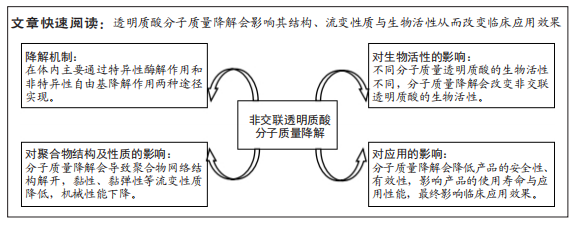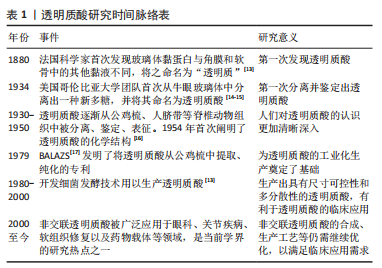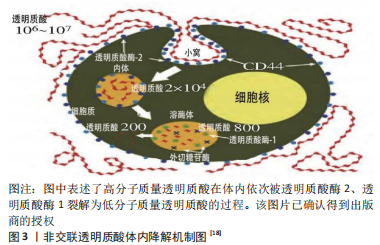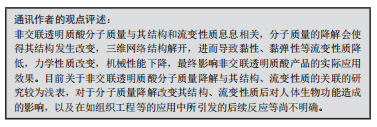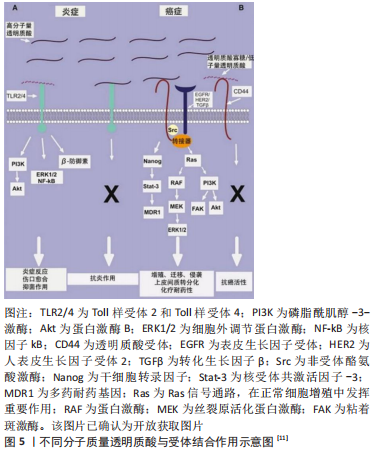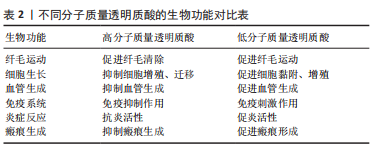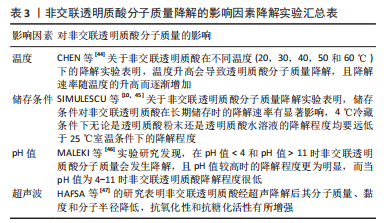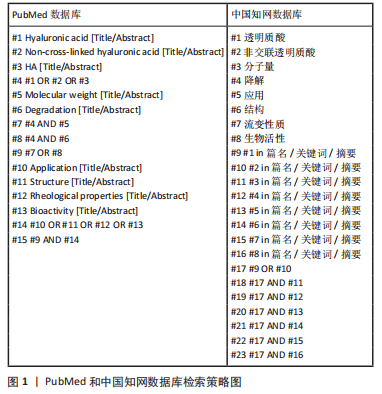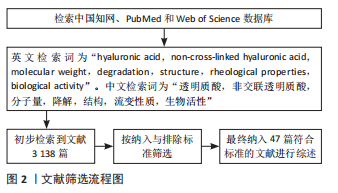[1] 杨卫,徐呈祥,陈则胜,等.基于生物聚合物伤口敷料的研究及应用进展[J].材料导报,2022,36(S1):523-527.
[2] SHOU Y, ZHANG J, YAN S, et al. Thermoresponsive chitosan/DOPA-based hydrogel as an injectable therapy approach for tissue-adhesion and hemostasis. ACS Biomater Sci Eng. 2020;6(6):3619-3629.
[3] THAPA RK, DIEP DB, TØNNESEN HH. Topical antimicrobial peptide formulations for wound healing: current developments and future prospects. Acta Biomater. 2020;103:52-67.
[4] AIDA TM, OSHIMA M, SHARMIN T, et al. Controlled conversion of sodium hyaluronate into low-molecular-weight polymers without additives using high-temperature water and fast-heating-rates. J Supercrit Fluids. 2020;155:104638.
[5] ZHANG A, LIU Y, QIN D, et al. Research status of self-healing hydrogel for wound management: a review. Int J Biol Macromol. 2020;164:2108-2123.
[6] ABATANGELO G, VINDIGNI V, AVRUSCIO G, et al. Hyaluronic acid: redefining its role. Cells. 2020;9(7):1743.
[7] HINTZE V, SCHNABELRAUCH M, ROTHER S. Chemical modification of hyaluronan and their biomedical applications. Front Chem. 2022;10:830671.
[8] SKANDALIS SS, KARALIS T, HELDIN P. Intracellular hyaluronan: importance for cellular functions. Semin Cancer Biol. 2020;62:20-30.
[9] 殷悦,李潼,王师平,等.富血小板血浆联合非交联透明质酸钠复合溶液填充治疗上睑凹陷疗效分析[J].中国美容医学,2020,29(10):6-10.
[10] SIMULESCU V, KALINA M, MONDEK J, et al. Long-term degradation study of hyaluronic acid in aqueous solutions without protection against microorganisms. Carbohydr Polym. 2016;137:664-668.
[11] TAVIANATOU AG, CAON I, FRANCHI M, et al. Hyaluronan: molecular size‐dependent signaling and biological functions in inflammation and cancer. FEBS J. 2019;286(15):2883-2908.
[12] GRAÇA MFP, MIGUEL SP, CABRAL CSD, et al. Hyaluronic acid-based wound dressings: a review. Carbohydr Polym. 2020;241:116364.
[13] FALLACARA A, BALDINI E, MANFREDINI S, et al. Hyaluronic acid in the third millennium. Polymers (Basel). 2018;10(7):701.
[14] 许磊,韩晓强,张锦涛,等.关节软骨细胞周围透明质酸产生、转化和功能特征[J].中国组织工程研究,2022,26(5):768-773.
[15] LIU L, LIU Y, LI J, et al. Microbial production of hyaluronic acid: current state, challenges, and perspectives. Microb Cell Fact. 2011;10:99.
[16] 刘晖,刘爱峰,张宇,等.透明质酸支架在软骨修复工程中的优势和应用策略[J].中国组织工程研究,2022,26(34):5518-5524.
[17] BALAZS EA. Ultrapure hyaluronic acid and the use thereof. US: US4141973,1979-02-27.
[18] DICKER KT, GURSKI LA, PRADHAN-BHATT S, et al. Hyaluronan: a simple polysaccharide with diverse biological functions. Acta Biomater. 2014;10(4):1558-1570.
[19] 雷曦,张蕊,黄遵锡,等.透明质酸酶的研究进展[J].微生物学通报,2021,48(3):882-895.
[20] GARANTZIOTIS S. Modulation of hyaluronan signaling as a therapeutic target in human disease. Pharmacol Ther. 2022;232:107993.
[21] SCHINZEL RT, HIGUCHI-SANABRIA R, SHALEM O, et al. The hyaluronidase, TMEM2, promotes ER homeostasis and longevity independent of the UPRER. Cell. 2019;179(6):1306-1318.e18.
[22] SNETKOV P, ZAKHAROVA K, MOROZKINA S, et al. Hyaluronic acid: the influence of molecular weight on structural, physical, physico-chemical, and degradable properties of biopolymer. Polymers (Basel). 2020;12(8):1800.
[23] HEATLEY F, SCOTT JE. A water molecule participates in the secondary structure of hyaluronan. Biochem J. 1988;254(2):489-493.
[24] SCOTT JE, CUMMINGS C, BRASS A, et al. Secondary and tertiary structures of hyaluronan in aqueous solution, investigated by rotary shadowing-electron microscopy and computer simulation. Biochem J. 1991;274(3):699-705.
[25] SCOTT JE, HEATLEY F. Hyaluronan forms specific stable tertiary structures in aqueous solution: a 13C NMR study. Proc Natl Acad Sci U S A. 1999;96(9):4850-4855.
[26] SCOTT JE. Supramolecular organization of extracellular matrix glycosaminoglycans, in vitro and in the tissues. FASEB J. 1992;6(9):2639-2645.
[27] ROSA DM, D’AGOSTINO A, GATTA LA, et al. Hybrd cooperative complexes of hyaluronic acid. US: US2013165404, 2013-6-27.
[28] 张堃,简军,张政朴.透明质酸的结构、性能、改性和应用研究进展[J].高分子通报, 2015,197(9):217-226.
[29] FALCONE SJ, PALMERI DM, BERG RA. Rheological and cohesive properties of hyaluronic acid. J Biomed Mater Res A. 2006;76A(4):721-728.
[30] JUNCAN AM, MOISĂ DG, SANTINI A, et al. Advantages of hyaluronic acid and its combination with other bioactive ingredients in cosmeceuticals. Molecules. 2021;26(15):4429.
[31] 蔡同凯,刘谋治,邓婕,等.透明质酸的作用机制及临床应用研究进展[J].药学实践杂志,2022,40(2):103-107,131.
[32] HOARAU A, POLETTE M, CORAUX C. Lung hyaluronasome: Involvement of low molecular weight Ha (Lmw-Ha) in innate immunit. Biomolecules. 2022;12(5):658.
[33] ROWLEY JE, AMARGANT F, ZHOU LT, et al. Low molecular weight hyaluronan induces an inflammatory response in ovarian stromal cells and impairs gamete development in vitro. Int J Mol Sci. 2020;21(3):1036.
[34] CUFF CA, KOTHAPALLI D, AZONOBI I, et al. The adhesion receptor CD44 promotes atherosclerosis by mediating inflammatory cell recruitment and vascular cell activation. J Clin Invest. 2001;108(7):1031-1040.
[35] 王彤,成亚飞,陈诚,等.透明质酸在烧伤整形美容外科中的应用进展[J].中国美容医学,2020,29(2):170-173.
[36] HUSSAIN SN, GOODMAN GJ, RAHMAN E. Treatment of a traumatic atrophic depressed scar with hyaluronic acid fillers: a case report. Clin Cosmet Investig Dermatol. 2017;10:285-287.
[37] MORAN M, NIETO-LOPEZ F, RUEDA-CARRASCO J. Lipoteichoic acid and molecular weight of hyaluronic acid could explain the late inflammatory response trigger by hyaluronic acid fillers. J Cosmet Dermatol. 2022;21(11):5610-5613.
[38] OWCZARCZYK-SACZONEK A, ZDANOWSKA N, WYGONOWSKA E, et al. The immunogenicity of hyaluronic fillers and its consequences. Clin Cosmet Investig Dermatol. 2021;14:921-934.
[39] 林建云,罗时荷,杨崇岭,等.生物基高分子型止血材料和伤口敷料[J].化学进展, 2021,33(4):581-595.
[40] WANG HC, YU N, WANG X, et al. Cerebral embolism as a result of facial filler injections: a literature review. Aesthet Surg J. 2022;42(3):NP162-NP175.
[41] KOKOSKA RE, LIMA AM, KINGSLEY MM. Review of delayed reactions to 15 hyaluronic acid fillers. Dermatol Surg. 2022;48(7):752-757.
[42] ALTMAN RD, BEDI A, KARLSSON J, et al. Product differences in intra-articular hyaluronic acids for osteoarthritis of the knee. Am J Sports Med. 2016;44(8):2158-2165.
[43] 刘志雯,黄慧娟,张军东,等.一种透明质酸钠凝胶的灭菌方法[P].上海: CN106139178A,2016-11-23.
[44] CHEN H, QIN J, HU Y. Efficient degradation of high-molecular-weight hyaluronic acid by a combination of ultrasound, hydrogen peroxide, and copper ion. Molecules. 2019;24(3):617.
[45] SIMULESCU V, MONDEK J, KALINA M, et al. Kinetics of long-term degradation of different molar mass hyaluronan solutions studied by SEC-MALLS. Polym Degrad Stab. 2015;111: 257-262.
[46] MALEKI A, KJØNIKSEN A-L, NYSTRÖM B. Effect of PH on the behavior of hyaluronic acid in dilute and semidilute aqueous solutions. Macromol Symp. 2008;274(1):131-140.
[47] HAFSA J, CHAOUCH MA, CHARFEDDINE B, et al. Effect of ultrasonic degradation of hyaluronic acid extracted from rooster comb on antioxidant and antiglycation activities. Pharm Biol. 2017;55(1):156-163.
|
